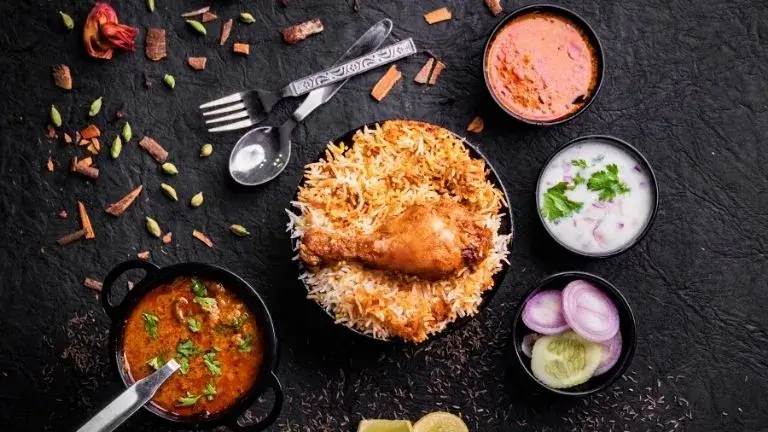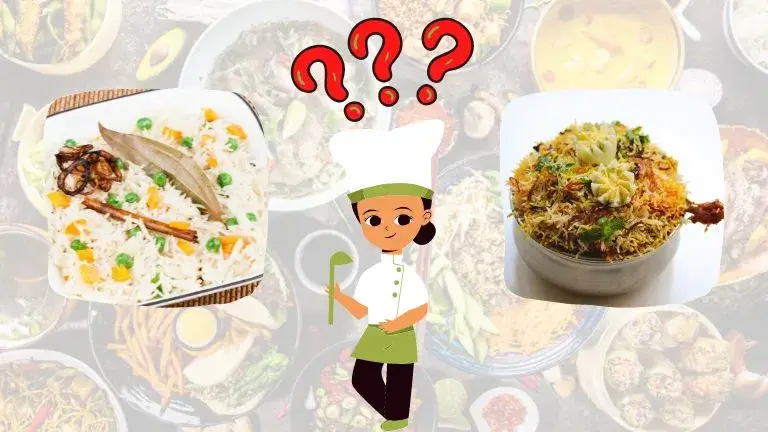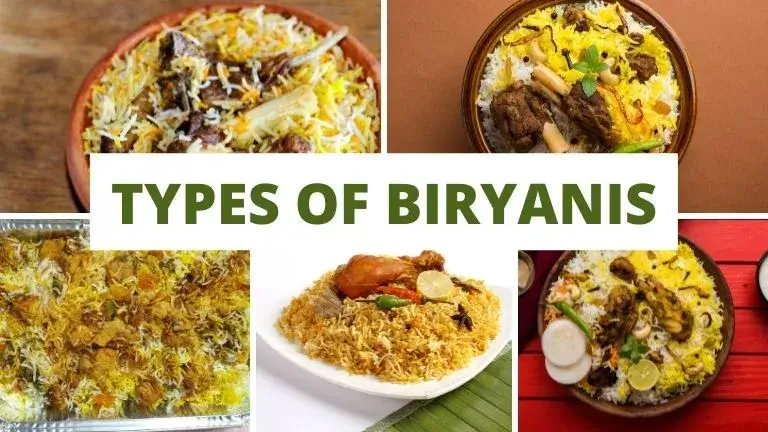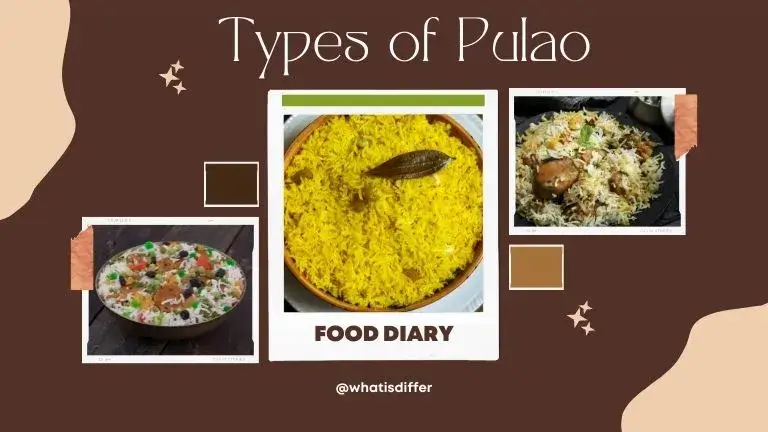The terms “biryani” and “pulao” often confuse because both are rice-focused dishes spiced with fried onions, coriander, and mint leaves.
The difference between Pulao and Biryani is that Biryani is Mughal originated while the roots of Pulao are from Afghanistan.
All nations enjoy eating Pulao and Biryani. Both dishes are celebratory and regal. Pulao and Biryani are universally loved. There is hardly a single person on earth who dislikes Biryani or Pulao.
For understanding the difference between Pulao and Biryani continue reading this article below:
Table of Contents
What is Biryani?

The word that excites appetite the most is “Biryani.”
A unique type of rice known as “basmati” is used to make Biryani. Because different types of rice have varying capacities for absorbing water, not all Basmati rice varieties can be used to make Biryani.
Rice and meat are the key ingredients of Biryani, served with chutney and raita made from curd. On the occasion of Eid, every home prepares this dish, which is highly well-liked among Muslims. Biryani is very spicy.
What is Pulao?

The rice that is readily accessible locally can be used to make Pulao.
Pulao is made by cooking the meat in warm aromatic spices in water until it is soft, then adding the rice to the meat soup with the meat, which is then sealed and cooked over low heat until it is finished.
Pulao is not spicy like Biryani, as it is made with regular seeraga-samba rice and with less spices.
Differences Between Pulao and Biryani

There are many differences between pulao and biryani given below:
The two dishes’ common origins are different. From Afghanistan, where it is still well-known today, Pulao was brought to India. The Pulao contained a lot of meat and dry fruits but little spice.
In contrast, Biryani has its roots in India. The Mughal emperors preferred one-dish meals that matched their royal customs. As a result, some creative chefs at the time created the Biryani, which featured whole garam masala, extremely tender meat, aromatic rice, and Kesar milk on top.
In comparison between pulao vs biryani, Biryani is prepared using the soaking method of cooking, which calls for boiling the rice in spiced water before layering it.
When making pulao, use the absorption method, which entails mixing two glasses of water with one glass of rice; the rice will absorb the water as it cools, creating Pulao.
Another comparison between biryani vs pulao is the method of preparation. While Pulao is made by sauteing the ingredients of rice formed of vegetables together before cooking in a predetermined amount of water, Biryani is always cooked in layers.
Next, more spices are used while making Biryani than when making Pulao, which gives the dish a richer flavor and texture.
Even occasionally, Biryani uses powdered spices, but whole spices, such as bay leaves and other items, are used in Pulao.
In terms of texture, Pulao is slightly moist, whereas Biryani is dry and fluffy.
Then comes taste and scent. While Pulao is lighter in taste and less in flavor, Biryani is rich in flavor and can disrupt focus when smelled as well as enhance the appetite.
For the duration of cooking, Biryani is a slow process that requires more time, whereas Pulao is a medium procedure that requires less time.
For Biryani, the chicken must be marinated in curd and spices for at least three to four hours. While the meat or veggies can be partially cooked to make gravy for Pulao.
Both Biryani and Pulao are served with Salad and Raita.
Comparison Between Pulao Vs Biryani in Terms of Types:
Types of Biryanis

These are the most famous types of Biryanis, which are rich in taste.
1. Lucknowi Biryani
The Northern Indian dish Lucknowi Biryani, also known as Awadhi biryani, utilizes spices including cinnamon and saffron. It’s frequently served as a festive dish and prepared in the “dum” style. Biryani from Lucknow, which is a little softer.
2. Bengali Biryani
Kolkata biryani, from Kolkata, India, is spiced with moderate spices in the rice and meat.
Bengali biryani also includes potatoes and beef.
3. Sindhi Biryani
Sindhi Biryani is a dish that originated in Sindh and came from chilies, spices, and the addition of potatoes.
4. Bombay Biryani
Bombay biryani, a moderate but delicious dish, is available. In addition to fried and spiced potatoes, it is cooked with chicken or mutton.
Adding kewra water and dried plums, which give the rice dish its uniquely sweet and acidic flavor, makes it unique.
5. Hyderabadi Biryani
Hyderabadi Biryani, an authentic dish with layers of fluffy rice, spices, and roasted onion, is aromatic, mouthwatering, and flavorful.
Types of Pulao

The most delicious types of pulao are given below:
1. Kashmiri Pulao
The tasty Kashmiri pulao is a rice dish where the rice is cooked in milk and stuffed with dry fruits and fruits that are a little sweeter.
2. Zafarani Pulao
Zafarani pulao is a delicious saffron rice dish with dry fruits and saffron sugar.
3. Afghani Pulao
Afghani pulao is a delicious rice dish made in the style of Afghanistan.
It is made with long-grain basmati rice, soup and may also contain meat, aromatic herbs, spices, dried fruits, nuts, and vegetables.
Cooking Process: Pulao Vs Biryani
Biryani Cooking Process
Firstly, the rice is prepared for Biryani by soaking, boiling, and draining it with entire spices. Then the beef is partially cooked after marinating in a sauce made of yogurt and spice powder. In a container that is lastly sealed, the parboiled rice and the meat (with masala) are layered. Either an oven or coals are placed on top if the vessel is being burned directly.
As a side dish, raita is a mixture of beaten yogurt, grated or diced cucumber, onions, and other spices served with the Biryani.
Watch the Complete Video of Biryani Recipe
Pulao Cooking Process
When making Pulao, the ingredients are slowly added one at a time to the pressure cooker, beginning with whole spices, onions, etc., followed by meat, etc.
The needed amount of boiling water is poured, the cover is closed, and the Pulao is cooked for the desired amount of time on low heat.
Dal, kabab and other salad fixings are typically served with Pulao.
Watch the Complete Video of Pulao Recipe
Comparison Table : Biryani Vs Pulao
Highlighting the main differences between pulao and biryani in the following table:
| Biryani | Pulao |
| In biryani, both meat and rice are cooked separately. | In pulao, both meat and rice are cooked together. |
| Biryani takes more time in cooking. | Pulao takes less time to cook. |
| Biryani is very spicy. | Biryani is less spicy. |
| In biryani, chicken will be marinated before cooking. | In pulao, there is no need for marination. |
| Rice will be layered in biryani. | There is no layering in biryani. |
Conclusion
Regarding the two dishes, there are minute variations. The difference between pulao and biryani is that when making biryani, the meat and rice are first cooked separately and then combined. It contains very little spices and is heavily flavored with things like kewra water.
While rice and meat are cooked together for making pulao. Pulao can use more fruits, dry fruits, and less meat. In essence, Pulao is a regal version of biryani.

